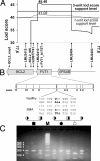A missense mutation in the 3-ketodihydrosphingosine reductase FVT1 as candidate causal mutation for bovine spinal muscular atrophy
- PMID: 17420465
- PMCID: PMC1868895
- DOI: 10.1073/pnas.0607721104
A missense mutation in the 3-ketodihydrosphingosine reductase FVT1 as candidate causal mutation for bovine spinal muscular atrophy
Abstract
The bovine form of the autosomal recessive neurodegenerative disease spinal muscular atrophy (SMA) shows striking similarity to the human form of the disease. It has, however, been mapped to a genomic region not harboring the bovine orthologue of the SMN gene, mutation of which causes human SMA. After refinement of the mapping results we analyzed positional and functional candidate genes. One of three candidate genes, FVT1, encoding 3-ketodihydrosphingosine reductase, which catalyzes a crucial step in the glycosphingolipid metabolism, showed a G-to-A missense mutation that changes Ala-175 to Thr. The identified mutation is limited to SMA-affected animals and carriers and always appears in context of the founder haplotype. The Ala variant found in healthy animals showed the expected 3-ketodihydrosphingosine reductase activity in an in vitro enzyme assay. Importantly, the Thr variant found in SMA animals showed no detectable activity. Surprisingly, in an in vivo assay the mutated gene complements the growth defect of a homologous yeast knockout strain as well as the healthy variant. This finding explains the viability of affected newborn calves and the later neuron-specific onset of the disease, which might be due to the high sensitivity of these neurons to changes in housekeeping functions. Taken together, the described mutation in FVT1 is a strong candidate for causality of SMA in cattle. This result provides an animal model for understanding the underlying mechanisms of the development of SMA and will allow efficient selection against the disease in cattle.
Conflict of interest statement
The authors declare no conflict of interest.
Figures





References
-
- el-Hamidi M, Leipold HW, Vestweber JG, Saperstein G. Zentralbl Veterinarmed A. 1989;36:731–738. - PubMed
-
- Siso S, Pumarola M, Ferrer I. J Comp Pathol. 2003;128:132–139. - PubMed
-
- Troyer D, Leipold HW, Cash W, Vestweber J. J Comp Pathol. 1992;107:305–317. - PubMed
-
- Medugorac I, Kemter J, Russ I, Pietrowski D, Nuske S, Reichenbach HD, Schmahl W, Forster M. Mamm Genome. 2003;14:383–391. - PubMed
-
- Krebs S, Medugorac I, Russ I, Ossent P, Bleul U, Schmahl W, Forster M. Mamm Genome. 2006;17:67–76. - PubMed
Publication types
MeSH terms
Substances
LinkOut - more resources
Full Text Sources
Medical
Molecular Biology Databases

